Cargo sorting zones in the trans-Golgi network visualized by super-resolution confocal live imaging microscopy in plants
- PMID: 33772008
- PMCID: PMC7997971
- DOI: 10.1038/s41467-021-22267-0
Cargo sorting zones in the trans-Golgi network visualized by super-resolution confocal live imaging microscopy in plants
Abstract
The trans-Golgi network (TGN) has been known as a key platform to sort and transport proteins to their final destinations in post-Golgi membrane trafficking. However, how the TGN sorts proteins with different destinies still remains elusive. Here, we examined 3D localization and 4D dynamics of TGN-localized proteins of Arabidopsis thaliana that are involved in either secretory or vacuolar trafficking from the TGN, by a multicolor high-speed and high-resolution spinning-disk confocal microscopy approach that we developed. We demonstrate that TGN-localized proteins exhibit spatially and temporally distinct distribution. VAMP721 (R-SNARE), AP (adaptor protein complex)-1, and clathrin which are involved in secretory trafficking compose an exclusive subregion, whereas VAMP727 (R-SNARE) and AP-4 involved in vacuolar trafficking compose another subregion on the same TGN. Based on these findings, we propose that the single TGN has at least two subregions, or "zones", responsible for distinct cargo sorting: the secretory-trafficking zone and the vacuolar-trafficking zone.
Conflict of interest statement
The authors declare no competing interests.
Figures
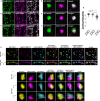
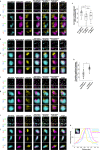
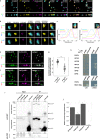
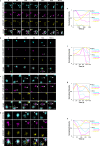
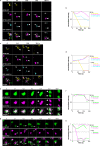
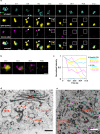

Similar articles
-
A Golgi-Released Subpopulation of the Trans-Golgi Network Mediates Protein Secretion in Arabidopsis.Plant Physiol. 2019 Feb;179(2):519-532. doi: 10.1104/pp.18.01228. Epub 2018 Dec 13. Plant Physiol. 2019. PMID: 30545905 Free PMC article.
-
Neofunctionalization of VAMP7 opened up a plant-unique vacuolar transport pathway.Curr Biol. 2025 Jun 9;35(11):2630-2641.e10. doi: 10.1016/j.cub.2025.04.062. Epub 2025 May 13. Curr Biol. 2025. PMID: 40367944
-
The Adaptor Complex AP-4 Regulates Vacuolar Protein Sorting at the trans-Golgi Network by Interacting with VACUOLAR SORTING RECEPTOR1.Plant Physiol. 2016 Jan;170(1):211-9. doi: 10.1104/pp.15.00869. Epub 2015 Nov 6. Plant Physiol. 2016. PMID: 26546666 Free PMC article.
-
Receptor-mediated sorting of soluble vacuolar proteins: myths, facts, and a new model.J Exp Bot. 2016 Aug;67(15):4435-49. doi: 10.1093/jxb/erw222. Epub 2016 Jun 4. J Exp Bot. 2016. PMID: 27262127 Review.
-
Clathrin and post-Golgi trafficking: a very complicated issue.Trends Plant Sci. 2014 Mar;19(3):134-9. doi: 10.1016/j.tplants.2013.10.008. Epub 2013 Nov 19. Trends Plant Sci. 2014. PMID: 24263003 Review.
Cited by
-
Identification of a novel Golgi-localized putative glycosyltransferase protein in Arabidopsis thaliana.Plant Biotechnol (Tokyo). 2024 Mar 25;41(1):35-44. doi: 10.5511/plantbiotechnology.23.1214a. Plant Biotechnol (Tokyo). 2024. PMID: 39464868 Free PMC article.
-
Disrupting cell wall integrity impacts endomembrane trafficking to promote secretion over endocytic trafficking.J Exp Bot. 2024 Jun 24;75(12):3731-3747. doi: 10.1093/jxb/erae195. J Exp Bot. 2024. PMID: 38676707 Free PMC article.
-
Proteomic characterization of isolated Arabidopsis clathrin-coated vesicles reveals evolutionarily conserved and plant-specific components.Plant Cell. 2022 May 24;34(6):2150-2173. doi: 10.1093/plcell/koac071. Plant Cell. 2022. PMID: 35218346 Free PMC article.
-
Editorial: Regulation of plant organelle biogenesis and trafficking.Front Plant Sci. 2023 May 26;14:1211807. doi: 10.3389/fpls.2023.1211807. eCollection 2023. Front Plant Sci. 2023. PMID: 37304708 Free PMC article. No abstract available.
-
New directions for the clathrin adaptor AP-1 in cell biology and human disease.Curr Opin Cell Biol. 2022 Jun;76:102079. doi: 10.1016/j.ceb.2022.102079. Epub 2022 Apr 13. Curr Opin Cell Biol. 2022. PMID: 35429729 Free PMC article. Review.
References
-
- Staehelin LA, Moore I. The plant Golgi apparatus: structure, functional organization and trafficking mechanisms. Annu. Rev. Plant Physiol. Plant Mol. Biol. 1995;46:261–288. doi: 10.1146/annurev.pp.46.060195.001401. - DOI
Publication types
MeSH terms
Substances
LinkOut - more resources
Full Text Sources
Other Literature Sources
Molecular Biology Databases
Miscellaneous

